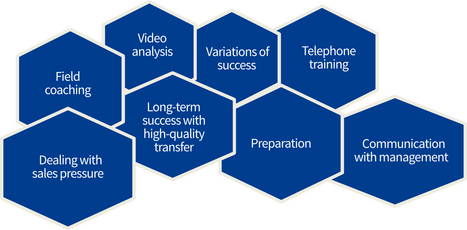
Holistic Sales Training – enjoyable training
The holistic sales training approach to closing more sales
Basically, there’s a difference between selling complex products and services and selling simple products and services. There’s also differences in the sales processes for both. The right approach for complex sales is to identify a potential customer’s problems, then integrate these into needs-based reasoning. There are 4 question techniques that play an important role in complex sales. By following this strategy, sales people can reduce the number of objections they have to counter by almost 60 percent. In turn, this makes it much easier for them to improve their closing rates.
When selling simple products and services, the focus is on closing the sale quickly. All you need are 2 or 3 standard questions to determine the customer’s needs. Successful argumentation is simpler, but more diverse and punchy.


Summary
Managers in the sales department get a strong sense of awareness and feeling for using individual communication in sales.

Summary
In order to be able to constantly develop staff, it is vital for managers to find out what motivations their staff have in different areas of life.
Summary
Sales managers recognise and accept the challenges of talking with staff about their personal development.

Summary
Making appointments only has one goal: to make an appointment!
Summary
The sales representative is able to set a specific goal for the first meeting. They understand the effect of their body language.
Summary
The sales representative understands the mechanics of conducting a sales conversation in order to effectively use a needs analysis to put their arguments forward. They know that without the right information from this stage, their position in price negotiations is weakened.
Summary
Writing a professional customised offer increases the strength of your arguments during price negotiations. The sales person understands the key points of writing and negotiating offers.
Summary
The sales person understands the negative effect of not being able to justify the price. They identify 100 percent with the product and its value. They understand how value is created.

Special topics can be integrated into general training or provided as individual building blocks.
Summary
Your overall sales goals have a significant influence on the successful implementation of your concept. We’ll talk about this in detail before the conceptual phase.

Summary
This form of training in a relaxed conversational style is highly effective put into practice. Improvements are made to subtle non-verbal and verbal behaviours.
Summary
I recommend the use of coaching in the preparation phase of a training concept. Observing what’s going on provides a real indication of the current sales behaviour as well as the perception of verbal and non-verbal cues.
Coaching in the field allows you to immediately assess sales conversations on-site. You can then provide direct training on how to change behaviour.
Summary
Sales staff actively confront the issues of stress and pressure. They recognise the causes and use techniques to overcome a crisis situation.
Summary
Good communication with managers on complex issues and goals transfers to the quality of results. In this module, staff learn how to communicate effectively with their manager.
Summary
Your managers learn the basic tools and know-how for successfully developing sales staff after they have had training.

The training focuses on the practical, everyday situations of your employees. These are played out several times, analysed and made better with new insights. The training is straight forward and easy to understand.
Your employees take what they have learned and set specific intentions of what they want to do. This is then tried out in their own company with competent assistance. The aim is to have a ‘light bulb’ effect. After every training session, I recommend that participants take 2-3 weeks to try things out.
The ‘light bulb’ effects are presented at the start of the next training session. The aim is to see how well the intentions have been implemented.
The content of the training sessions is customised to your requirements, based on the preliminary discussion I have with you.
This is documented in writing for you.
Documentation for the participants is done after the training. It contains technical and scientific information, photos of all flip charts and corresponds exactly to the training content. As such, the documentation can be up to 50 pages.
You' ll never walk alone
0151 / 25351294